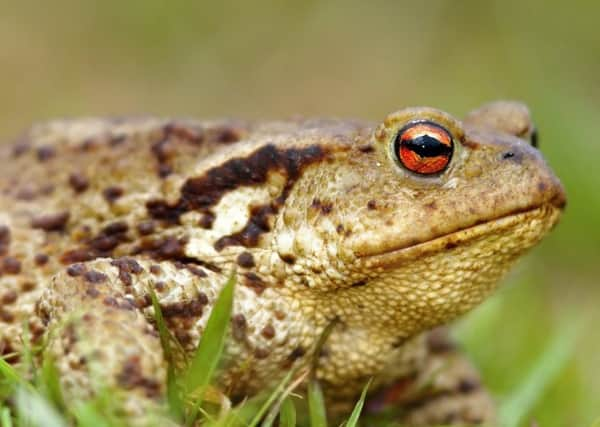Ilona Amos: Toads cross the road to get to the other side, but they need our help


It’s the time of new life. And the time when many young wildlife enthusiasts head for their nearest ponds and ditches to gather “materials” for an important biological research project. I’m talking about frog or toad spawn, of course. Watching the cycle of life, as the jelly-covered eggs transform into tadpoles, then grow legs and lose their tails before hopping off to start the whole process again, is surely an important part of any youngster’s education.
We have six native species of amphibian in Scotland – three newts, one frog and two toads. Of the toads, the natterjack is so rare it is found only at a handful of sites on the south coast in Dumfriesshire. The other is the common toad, though nowadays that’s a bit of a misnomer.
Advertisement
Hide AdAdvertisement
Hide AdGenerations of children have grown up loving Mr Toad from The Wind in the Willows, while George Orwell wrote “a toad has about the most beautiful eye of any living creature”. But recent research shows the common toads is in serious trouble. Numbers across the UK have fallen by a staggering 68 per cent over the last 30 years.
The reasons for this decline are numerous, according to the conservation charity Froglife. Populations are under threat from habitat loss due to building developments, farming practices including pesticide use, introduced diseases and the impacts of climate change. Road kill is another major factor.
At this time of year toads undertake large-scale migrations in order to mate and lay eggs, which often means crossing roads to reach breeding ponds. This results in thousands being squashed under the wheels of passing cars on spring evenings.
Street drains and cattle grids are also potentially deadly. They can act as traps for amphibians and other small animals. Once inside they’ll often starve or drown – or both.
The good news is that we can all help, and a few fairly simple actions could make a big difference to the survival rate.
Froglife Scotland has named 2017 as the Year of the Toad in the hope of raising awareness about their plight. One ongoing initiative is the development of toad patrols, first launched in the 1950s and continuing to do important work today. These involve voluntary teams collecting migrating amphibians, ferrying them across roads – often in buckets or sandwich boxes – and delivering them to spawning sites.
We can also make nature-friendly modifications to some man-made hazards. Installing special wildlife kerbs can allow unsuspecting amphibians to pass a drain edge safely, while adding custom-made escape ladders raises the survival rate further.
Similarly, a basic wooden ramp inserted in the corner of a cattle grid can give small animals the way out they need. We can do this ourselves. Experts suggest scoring grooves in the ramp to offer grip, and making sure the device will not topple over or float away during floods.
Advertisement
Hide AdAdvertisement
Hide AdSome councils already demand features such as these are installed at new developments.
Around 90,000 toads are currently helped across roads each year by toad patrols at 160 sites. It’s an impressive figure, but extra help is needed. Froglife is calling for people to get involved, either by joining existing patrols or by identifying where new ones should be set up. If you want to lend a hand or find out more, check out the charity’s Scottish Dragon Finder project.